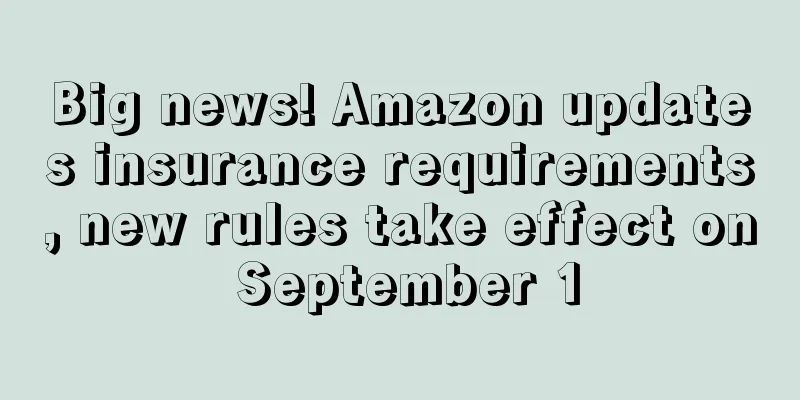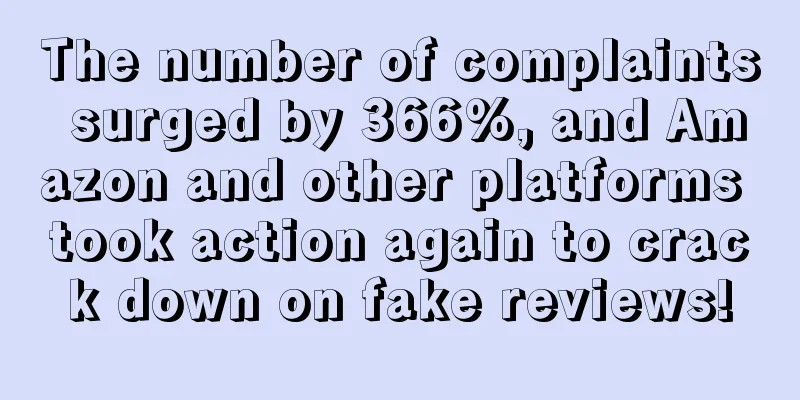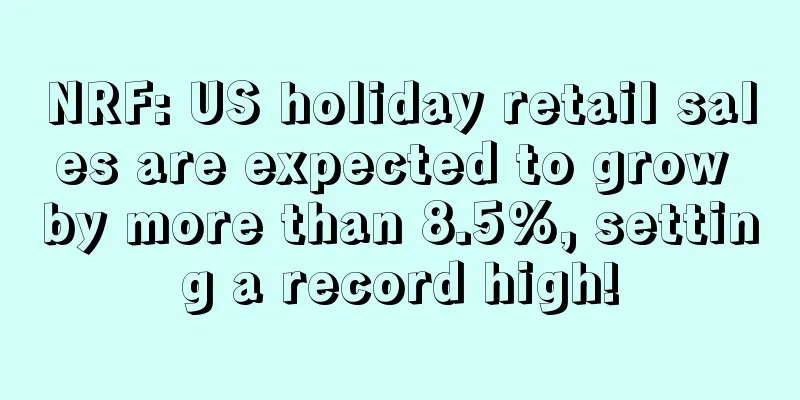Big news! Amazon updates insurance requirements, new rules take effect on September 1

|
In February of this year , Amazon sent an insurance requirement notice to sellers, requiring sellers with a total sales of US$10,000 in three months to purchase at least US$1 million in commercial insurance. The sellers who received the email have purchased it as required, and the insurance incident was not mentioned in the following months, as if it had been forgotten.
Yesterday, Amazon released a news notice that it will expand A-to-z protection from the insurance aspect , update seller insurance requirements, and launch an insurance accelerator. According to the new insurance regulations, sellers who have monthly sales of $10,000 on the US site are required to purchase product liability insurance. Some sellers have received emails at the same time, and the new regulations will take effect on September 1.
Amazon Insurance Requirements Updated, Effective September 1
After the "insurance boom" in February and March , the insurance incident seemed to have come to an end. However, at the end of July, a seller saw the following insurance requirement policy in the "backstage help":
"Amazon's Article 9 states that if your total monthly sales revenue exceeds $10,000 for three consecutive months, or if we require otherwise, you must purchase and renew commercial liability insurance within 30 days." The seller in question said that according to the manager, he would receive an email notification in a few days.
Yesterday, some sellers began to receive emails notifying them of the new insurance regulations. Soon, Amazon released a full notice of "Extended Amazon A-to-z Protection" in the backend and the US seller forum .
Amazon said it is expanding its Amazon Marketplace Guarantee to protect both buyers and sellers when defective products sold through Amazon.com result in property damage or personal injury. Starting September 1, 2021, Amazon will:
1. Provide both parties with an efficient process for resolving such claims. 2. Pay valid claims under $1,000 and will not seek compensation from sellers with valid insurance. 3. With the help of Amazon Insurance Accelerator, sellers can more easily purchase insurance at competitive prices.
Amazon then gave a detailed explanation of each of these three points.
1. Expand A-to-z protection to resolve defective product claims for buyers and sellers
In the past, when buyers believed that defective goods caused them property damage or personal injury , they would directly contact the seller to seek compensation, which was an unpleasant experience for both parties. So Amazon established a new process to solve this problem:
Starting September 1, 2021, Amazon will assist in resolving property damage and personal injury claims between buyers, sellers, and their insurance providers for products sold through Amazon.com. Buyers can contact Amazon Customer Service, and we will notify the seller and help resolve the claim. If the seller does not respond to the claim, Amazon will step in and resolve the buyer's issue directly, at its own expense, and then pursue the seller solely. Amazon may also step in to resolve the buyer's issue if the seller rejects a claim that we deem to be valid; in this case, the seller will continue to have the opportunity to defend the claim against its own products.
When a buyer files a claim, Amazon will combine its fraud and abuse detection system with external independent insurance fraud experts to analyze the claim, submit valid claims to sellers, and reject unsubstantiated, frivolous or abusive claims. Amazon will do this on behalf of sellers, and sellers do not need to investigate these claims themselves.
2. Amazon pays claims under $1,000
For valid property damage and personal injury claims filed against sellers, if the amount is less than $1,000, Amazon will be responsible for resolving and paying the relevant amounts as compensation to the buyer. More than 80% of claims on Amazon are claims under $1,000. Amazon will bear these costs and will not seek compensation from sellers who comply with the policy and have valid insurance. These compensations will not affect the seller's order defect rate, but the seller will be notified of each step.
3. Update seller insurance requirements and launch insurance accelerator
According to Amazon's current regulations, sellers with sales of $10,000 or more on Amazon for three consecutive months must purchase product liability insurance and designate Amazon as an additional insured. This requirement will be updated soon. Starting September 1, 2021, the platform's Business Solutions Agreement will require sellers with monthly sales of $10,000 or more on Amazon.com to purchase product liability insurance and designate Amazon as an additional insured.
New sellers or existing sellers who are familiar with the new policy can learn about the Amazon Insurance Accelerator, which Amazon has created in collaboration with insurance brokers. This is a network of vetted insurance providers. They will make an assessment and, where appropriate, provide liability insurance to eligible sellers at competitive rates. Amazon will continue to expand the Insurance Accelerator network to include more providers.
Sellers who already have insurance must confirm that the insurance is up to date and saved on the Commercial Insurance page in Seller Central.
(Screenshot of the Meiya announcement)
The seller is panicking. How can he buy insurance?
After receiving the email from Amazon, many sellers panicked, and multiple seller groups discussed the topic at the same time. Because it was a matter of account security, no one dared to be careless, and they asked their peers whether they would buy the product, and the conditions, details, fees, requirements, etc. of the purchase.
According to the latest requirements, Amazon has set a deadline of September 1st, and sellers with sales exceeding $10,000 in any month must purchase insurance. Most sellers have reached this sales amount, so the proportion of sellers who need to purchase insurance is very high. And this platform regulation applies to the entire site.
According to the summary of @下饭猫, a seller in the industry , on the basis of purchasing insurance for the entire site, sellers need to insure different stores separately. The insurance covers the entire store, and there is no separate insurance for different ASINs. At present, the insured of the policy corresponds to the company, and it seems that personal stores cannot be insured.
Insurance will be measured based on the seller's sales, so can the seller fill in the sales randomly? The terms and conditions clearly state that the store sales will be audited and/or verified. If the actual sales of the enterprise are higher than the estimated sales, the insured must pay the premium based on the actual sales. Therefore, filling in randomly is not allowed.
The insurance policy purchased by the seller takes effect on the same day and is valid for one year.
When the new insurance requirements were released, Amazon also selected several companies such as Ping An and PICC to facilitate sellers to choose. You should try to choose an insurance company that Amazon has selected well, which will be relatively more secure.
At present, it is relatively convenient for sellers to purchase insurance. Taking PICC as an example, sellers only need to submit their insurance requirements online, and then the insurance company will issue a payment notice to the seller's mailbox. After the seller pays the premium, the insurance company will issue an insurance policy and insurance certificate to complete the insurance. After submitting the insurance requirements online, you can get the insurance policy and certificate that meet the requirements of the Amazon platform within one working day.
Insurance costs are a concern for most sellers. It is understood that depending on the seller's sales, product categories, and insurance forms, most sellers' insurance costs range from a few hundred yuan to several thousand yuan. Except for high-risk products and non-electric products such as lighting and electrical appliances, PICC's minimum premium is 500 yuan , with a rate of 0.06%. In addition to the premium, no additional fees will be charged, and risk control suggestions can be provided to sellers.
Scan the QR code below to learn more insurance details and sign up for insurance.
Amazon, Insurance |
<<: Instagram is testing new advertising features to further develop social e-commerce
>>: You can get your money back! WishPost launches A+ Logistics Refund Guarantee Program
Recommend
What is MiKe? MiKe Review, Features
MiKe is a company engaged in online education in ...
What is Casper Mattresses? Casper Mattresses Review, Features
Founded in 2014, Casper Mattresses is a DTC home ...
The heating category has a tough battle this year. Sellers: The low-price spiral is in place
"The weather in Europe in December last year...
U.S. alpine and snowboard equipment sales accelerate as pandemic restrictions ease
Industry data shows that off-piste-related produc...
What is Nanyangyi Cross-border E-commerce Service Platform? Nanyangyi Cross-border E-commerce Service Platform Review, Features
Nanyangyi Cross-border E-commerce Service Platform...
Cross-border Communication issued an announcement, and we finally know the real reason why Paton was sold!
Performance decline, debt accumulation, urgent ne...
Two major brands ranked first in the United States! Amazon made a net profit of 500 million US dollars
Unlike traditional home appliance giants that foc...
Demand cools! Amazon cancels and postpones two major warehouse expansion plans
According to foreign media reports, Amazon cancel...
Aihuishou plans to go public in the U.S. in early June; online second-hand trading platform market is booming
On April 18 , it was reported that Aihuishou, a s...
What is Xiamen Zhushida Technology Agency Operation? Xiamen Zhushida Technology Agency Operation Review, Features
Xiamen Zhushida Technology Co., Ltd. was founded b...
What is Health-Ade? Health-Ade Review, Features
Health-Ade is a kombucha brand that was founded i...
What is Sandeng Supply Chain? Sandeng Supply Chain Review, Features
Sandeng Supply Chain is a professional internatio...
What is Robokassa? Robokassa Review, Features
<span data-docs-delta="[[20,{"gallery"...
What is Letter of Credit (LC)? Letter of Credit (LC) Review, Features
A letter of credit (L/C) is a document issued by ...
Prime Day will continue to be a hot sales season for many categories, but sellers are reluctant to offer big discounts
Amazon Prime Day is about to kick off, and some a...









